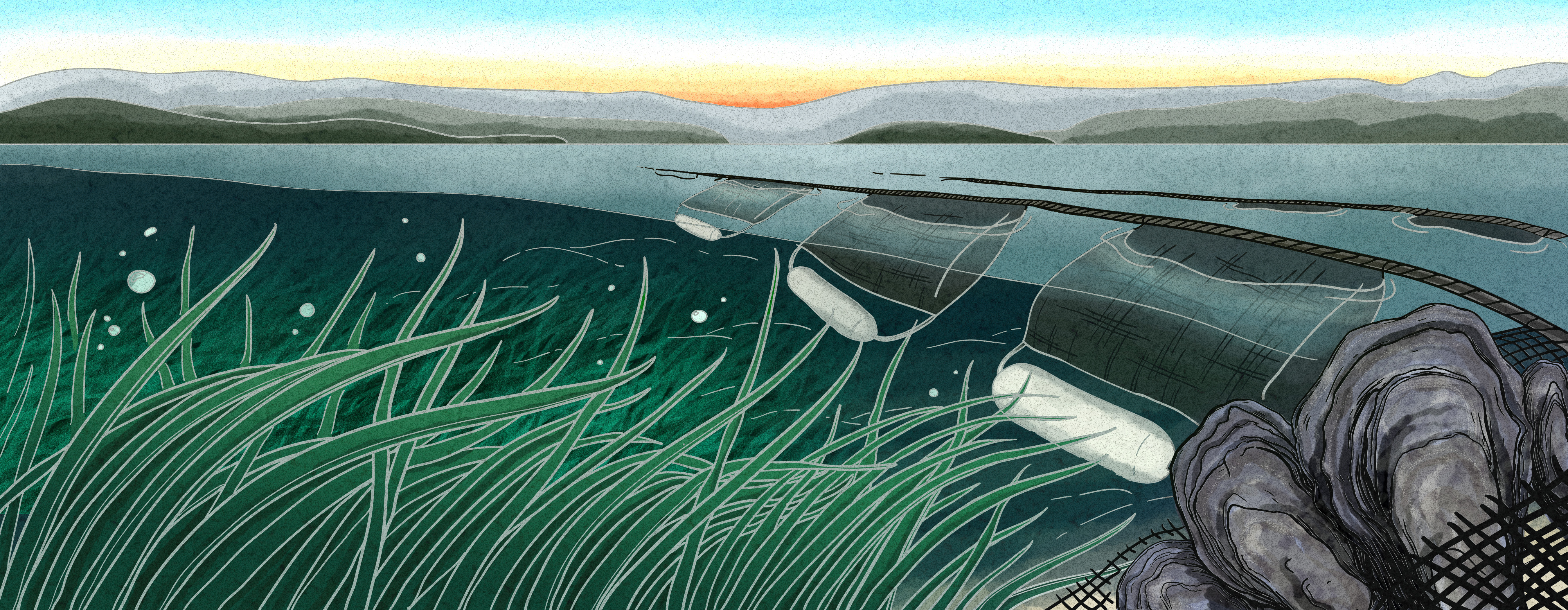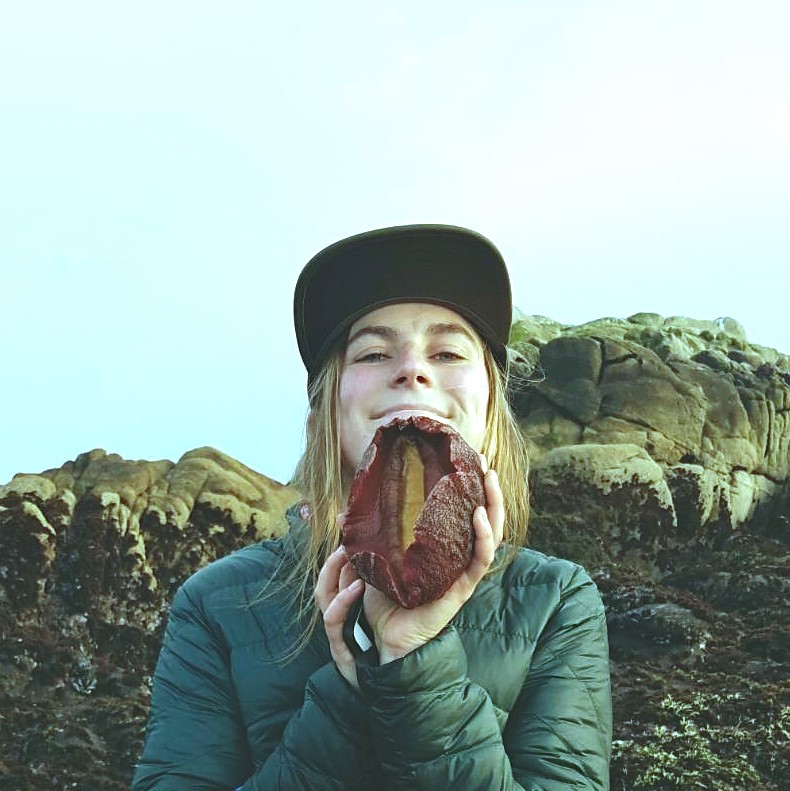Eelgrass and oysters: antagonists or allies?
Seagrass may protect aquaculture from an acidifying ocean, Jesse Kathan reports. Illustration by Emma Vogan.

Illustration: Emma Vogan
On the rocky shores of Tomales Bay, a drone sits atop a white towel, refusing to fly.
Sarah Lummis hunches over its controls a few meters away. She checks and rechecks the Bluetooth, the batteries, the programmed flight plan.
A minute later, with seeming capriciousness, rotors start spinning. The drone beeps and rises from the beach with eerie precision, ascending 200 meters before setting off over the bay.
With what light remains, the oyster racks are still visible, the neat rows of mush bags sitting just above the waterline. Beyond the racks, in slightly deeper water, beds of eelgrass sway gently with the tug of the tide. These aren’t visible from shore, but Lummis is hoping they will be to the drone.
An ecology graduate student at University of California, Santa Cruz, Lummis is mapping eelgrass beds using drone images. She visits the bay every month, surveying eelgrass beds with and without nearby oyster aquaculture gear. Regulators, and a body of previous research, see aquaculture as a threat to the ecosystem, but Lummis is examining the idea that that the two could be mutually beneficial. Her results are still preliminary, but she says this line of inquiry could lead to “a major attitude shift” – one that evaluates oyster growers not just on what they take from natural environments, but what they give back.
* * *
The eelgrass Lummis studies is a type of seagrass, a marine plant that lines bays and estuaries worldwide. “They create very important habitat that benefits many other species,” said Walter Heady, a coastal ecologist with The Nature Conservancy in Santa Cruz.
Eelgrass beds transform barren mudflats into a rich web of animal activity. Microscopic zooplankton feed on the plants, while juvenile salmon feed on the zooplankton. Pacific herring lay eggs on the leaves, and young Dungeness crab seek refuge between the stems. Underground, rootlike rhizomes oxygenate the soil, attracting clams and snails.
Besides providing habitat for sea-dwelling animals, eelgrass can also help preserve the surrounding marsh. Within the past 200 years, California has lost over 90% of its historic wetlands. “That last 10% is really vulnerable to further losses from erosion, or from sea level rise,” said Heady. “That’s where eelgrass comes in to help out this other habitat.” The mass of leaves softens waves that cause erosion and traps sediments that would otherwise be swept out of sea. The neighboring marsh accumulates sediment and slowly gains elevation, preventing it from being flooded by rising seas.
Historically, the San Francisco Bay was filled with eelgrass beds. But sedimentation from mining and agriculture, and construction and dredging along the shoreline, has all but eliminated the habitat from the San Francisco Bay and large swaths of the California coast. “It’s a huge part of the California ecosystem that has mostly been lost,” said ecologist Tess Hill of the University of California, Davis.
The plant’s wide range on the West coast, and a lack of comprehensive monitoring programs, makes assessing the ecosystem’s current health challenging. In late spring of 2013, California Sea Grant ecologist Joseph Tyburczy noticed piles of eelgrass leaves washed up on shore of Humboldt Bay. Shedding is a normal process, but it usually happens in mid to late summer. The early shed raised eyebrows across the state. “A lot of people noticed, but there was no on-the-ground monitoring to get a good handle on how that altered the abundance or distribution of eelgrass.”
Some places, though, have seen severe declines. California’s Morro Bay lost 97% of its eelgrass habitat between 2007 and 2015. Researchers still aren’t sure why.
Ecologists are worried about the loss of seagrass, and not just out of concern for the plant itself. The disappearance of eelgrass can collapse entire ecosystems. In the 1930s, the Atlantic coast lost more than 90% of its eelgrass beds to Eelgrass Wasting Disease, a condition caused by a waterborne microbe. The results were wide-ranging and catastrophic: fisheries collapsed, a limpet went extinct, and a goose that grazes on the plant underwent declines so severe that its migration patterns have been permanently altered. More recently, declines of eelgrass in Puget Sound in 2003 caused some populations of Pacific herring to go extinct.
Of the habitat in California, Hill says, “The existing pockets that we have, we should be protecting and conserving them, and allowing them to grow as much as possible.”
Because eelgrass beds are so important to commercially-fished species, California heavily regulates any activities that might impact the beds. In 2014, the National Marine Fisheries Service created the California Eelgrass Mitigation Policy (CEMP), a set of guidelines for any project, such as aquaculture or dredging, that might impact the ecosystem. If regulators do any eelgrass will die as a result of the project, the company undertaking the project must compensate for the loss by planting an equivalent amount of eelgrass.
It’s not only the oyster-growing gear itself that can harm eelgrass beds, said Cassidy Teufel, California Coastal Commission senior environmental scientist. “It’s the traveling effects associated with planting and harvesting.” Even if people aren’t walking directly on the beds, he says, sediment kicked up from mudflats can travel, settling on nearby eelgrass and making it more difficult for the plants to photosynthesize. Propeller boats used to access the oysters can also leave trails of cut eelgrass. “It’s pretty visible in aerial photos,” he said.
Lummis acknowledges that aquaculture can have detrimental effects on local ecosystems. But she says oysters shouldn’t be solely seen as eelgrass antagonists. In the right circumstances, they might even be allies.
* * *
“A lot of people, they’ll just slurp the oyster down,” says Gary Fleener. “But when you chew the muscle, it releases this sweetness.”
A group of scientists huddle around a cooler on an overcast Santa Cruz beach, watching as Fleener produces oyster after oyster from a mesh bag, shucking each with practiced ease. As quickly as he places the half-shells down, the scientists, Lummis among them, pick them up and relieve them of their salty contents. Though most of the group study oysters, two have never tasted them.
Fleener is the chief ecologist at Hog Island Oyster Company, an oyster grower based in Tomales Bay that operates its own restaurants in Marin, Napa, Marshall and San Francisco. Hog Island produces 3.5 million shellfish every year in Tomales and Humboldt Bays, most of it oysters. These are grown in bags hung from steel racks a few feet above the mud. Once a week, a crew comes out to shake the bags, strengthening the oysters’ muscles and preventing them from growing algae. “It’s like ranching on wild lands,” Fleener says. “Your animals are actually out in a completely natural ecosystem.”
Fleener is well aware of the potential negative effects of his gear on the surrounding ecosystem. But a few years ago, he and his crews started noticing something: eelgrass beds growing near the gear were expanding. In the bare mud beneath the oyster bags, new shoots emerged. That made him wonder if the oysters might be having a beneficial effect. After conversations with Heady, The Nature Conservancy developed a grant funding Lummis’s work. “In history, natural habitats like native oysters and eelgrass are really important for each other,” said Heady. To test the claim, Lummis is monitoring the growth of six eelgrass beds in Tomales Bay. At the start of the study, none had aquaculture gear nearby. Now, half of them have Hog Island oysters growing nearby. Eelgrass beds naturally expand and contract over seasons, so Lummis is collecting data for three years to see what lasting effect the gear has.
Fleener hopes that evidence of a mutually beneficial relationship could change the way regulators think about aquaculture. But he’s also invested in eelgrass growth for another reason – as a method of easing the effects of ocean acidification. Thirty percent of atmospheric carbon dioxide emissions are absorbed by oceans. “It’s as a tremendous sponge for carbon,” says Hill. That carbon makes ocean waters more acidic, weakening the shells of animals both wild and farmed. Acidification has already started to affect the oyster industry. Around ten years ago, the hatcheries who supplied Hog Island with baby oysters, or spat, started facing shortages. Weakened shells were making the spat more susceptible to predators and disease. In response, Hog Island opened its own oyster hatchery in Humboldt, using chemical additives to keep hatchery waters at a healthy pH for fragile larvae and spat.
But healthy eelgrass beds may be able to dampen the effects of ocean acidification. As a plant, eelgrass takes up CO2, decreasing the acidity of the surrounding water. Hill has monitored the pH of water both within and outside of eelgrass beds and has seen that when the eelgrass is at its most lush in spring and summer, the water near the eelgrass is less acidic than the surrounding sea, creating a more habitable environment for oysters. California is relying on the plant to help soften the effects of future acidification. In 2016, the state passed SB 1363, which ordered the state Ocean Protection Council to create an eelgrass restoration plan in hopes of mitigating ocean acidification.
The plan has directed funds towards research like Lummis’ across the California coast. Tess Hill of the University of California, Davis is collaborating with researchers from Humboldt to Long Beach to study the effects of eelgrass on local water chemistry. Lummis says the government investment in eelgrass is heartening. “It’s one of those rare cases where like the political will is at least matched up with the science,” Hill said. Fleener, for his part, sees eelgrass as a crucial partner in keeping these waters hospitable to his animals.
* * *
At one of Hog Island’s racks, toward the southern end of Tomales Bay, the mud is dense enough to walk on without sinking in. Lummis traces a transect extending from the oyster gear to the adjacent eelgrass bed. Every few steps, she places a small square frame on the bay floor and counts each shoot. At low tide, the remaining water pools in a few isolated puddles, and she can comfortably walk between the rows of racks and bags. On high-tide days, she uses a boat and scuba suit to access the beds. “Some days it looks like you’re swimming through prairie grasslands,” she said. On others, the water is often so murky she can barely see, and she counts by touch alone.
“Some days it looks like you’re swimming through prairie grasslands,” she said. On others, the water is often so murky she can barely see, and she counts by touch alone.
By counting the number of shoots within the small squares, Lummis is able to estimate the total coverage of eelgrass. That’s the method California Eelgrass Mitigation Policy mandates be used. Under this policy, any company undertaking a coastal project that may impact eelgrass, including dredging and aquaculture, must survey the eelgrass beforehand. Oyster growers usually hire an external environmental consultant to conduct the surveys, a process as arduous as it is expensive. Fleener says the surveys don’t account for the way eelgrass beds naturally grow and contract over the years. “The regulatory environment is currently set to eelgrass mapping that was done years ago,” he said. “In some places the baseline lines up with reality, in some places it doesn’t.”
Lummis is conducting the traditional surveys in tandem with the drone flights. She’s hoping to show that drone imagery can be used as a cheaper, less time-intensive form of assessment, one that can better illustrate how the beds grow and contract over time. The Coastal Commission isn’t against the idea. “Bear in mind that the CEMP guidelines were developed in 2014. That wasn’t long ago, but there certainly wasn’t the availability of UAV [unmanned aerial vehicles] that we have today,” said the coastal commission’s Teufel. The commission has already allowed the use of drone imagery to map eelgrass near a large aquaculture project in Humboldt Bay.
Besides being easier to collect, the drone imagery also allows Lummis to see at a glance how the beds she studies have changed over the past thirty months of sampling. Two years ago, this bed was nearly buried after a storm brought a slug of sediment down a nearby creek. Lummis was afraid the eelgrass might be gone for good. Instead, now, both the transect surveys and drone photography suggest that the boundaries of the bed are expanding. A nearby bed without oyster equipment is staying the same size, leading Lummis to believe Fleener’s observations may bear scientific fruit. Her results are too preliminary to make any concrete claims about whether the oysters are helping the eelgrass, but she has some ideas about how they might.
As filter feeders, oysters remove sediment from the water and increase its clarity, which could make it easier for plants to photosynthesize. The physical structure of the racks they grow on, which break incoming waves, could also decrease the physical stress on the plants.
A lab experiment by Maya Groner of the US Geological Survey suggests that oysters could even inhibit Eelgrass Wasting Disease by eating the Labyrinthula zosterae, the pathogenic protist that causes the disease. “Oysters are very effective filter feeders, but they’re picky feeders, so we weren’t sure if they would consume Labyrinthula,” Groner said. Groner says she didn’t see disease in the eelgrass grown with oysters, though she cautions results seen in the lab don’t always translate to the wild.
* * *
Jennifer Ruesink of the University of Washington has studied wild oysters and eelgrass in Washington for more than a decade. The intertidal waters of Puget Sound host hundreds of aquaculture operations at densities much higher than those in California. Some companies use the mesh bags common in California, but others plant young oysters directly on the bay floor, returning months later to dredge the adults up from the mud. Ruesink has found that in the short term, growing oysters can kill eelgrass, but it quickly grows back. Her experiments haven’t yielded any evidence that aquaculture could be assisting the growth of eelgrass: “It’s resilient to the disturbances, but it’s not facilitated by those disturbances.”
However, she says what she sees in Washington might not hold true for California. Species are more likely to form mutually beneficial relationships in stressful environments. Lummis thinks that eelgrass in Tomales might benefit from the water-clarifying or wave-breaking assistance of oysters, but Ruesink the eelgrass ecosystem in Puget sound may be so healthy that it doesn’t need any extra help. Lummis’ line of inquiry, she said, is “something that I feel like is still totally worth pursuing.”
Lummis continues pursuing, planning to continue the monitoring for at least another year. She hopes future research will show better ways for human activities and natural habitats to coexist – and that she can bring attention to the importance of eelgrass. “They’re just beautiful plants,” she said. “I want people to know they’re worth protecting.”
© 2020 Jesse Kathan / UC Santa Cruz Science Communication Program

Jesse Kathan
Author
B.S. (wildlife, fish and conservation biology) University of California, Davis
Internships: Monterey County Weekly, Inside Science News and KSQD
Jesse is a freelance science journalist covering climate change, public health and ecology and LGBT issues. Their work has appeared in The Mercury News, Eos, Inside Science and more. Before becoming a journalist, Jesse conducted fisheries research in the Sacramento-San Joaquin delta, where they gained a great appreciation for sturgeon and never quite learned to drive a boat. They currently live in Sacramento, where they enjoy walking along the river, cooking for their 11 housemates and re-reading Octavia Butler novels.

Emma Vogan
Illustrator
B.A. (environmental studies) University of California, Santa Barbara
Internship: UC Santa Barbara Moorea coral reef ecology animation, Seymour Marine Discovery Center
Emma is an illustrator and animator based on the central California Coast. Drawing from times pent in the ocean and trekking through chaparral backcountry, much of her work reflects the ecosystems she has traveled through and lived in. Through illustration she aims to promote environmental awareness and a general excitement for marine life. Before studying science illustration at CSU Monterey Bay, she received her BA in Environmental Studies from UC Santa Barbara, worked as a naturalist with the Catalina Island Conservancy, and cooked on a dive boat while freelancing in printmaking and painting. Her work in art and graphic design has included projects promoting sustainability and education with the Surfrider Foundation and the Catalina Island Conservancy, as well as creative collaborations with musicians and small businesses along the Central Coast.